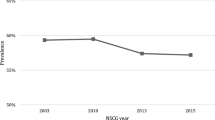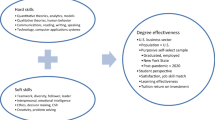Abstract
Gaps between science, technology, engineering, and mathematics (STEM) education and required workplace skills have been identified in industry, academia, and government. Educators acknowledge the need to reform STEM education to better prepare students for their future careers. We pursue this growing interest in the skills needed for STEM disciplines and ask whether frameworks for 21st century skills and engineering education cover all of important STEM competencies. In this study, we identify important STEM competencies and evaluate the relevance of current frameworks applied in education using the standardized job-specific database operated and maintained by the US Department of Labor. Our analysis of the importance of 109 skills, types of knowledge and work activities, revealed 18 skills, seven categories of knowledge, and 27 work activities important for STEM workers. We investigate the perspectives of STEM and non-STEM job incumbents, comparing the importance of each skill, knowledge, and work activity for the two groups. We aimed to condense dimensions of the 52 key areas by categorizing them according to the Katz and Kahn (1978) framework and testing for inter-rater reliability. Our findings show frameworks for 21st century skills and engineering education do not encompass all important STEM competencies. Implications for STEM education programs are discussed, including how they can bridge gaps between education and important workplace competencies.

Similar content being viewed by others
References
ABET (2015) Criteria for accrediting engineering programs, 2015–2016. http://www.abet.org/accreditation/accreditation-criteria/criteria-for-accrediting-engineering-programs-2015-2016/#outcomes. Accessed 19 Aug 2015
Ackerman PL (1988) Determinants of individual differences during skill acquisition: cognitive abilities and information processing. J Exp Psychol Gen 117(3):288–318
Adams WK, Wieman CE (2011) Development and validation of instruments to measure learning of expert-like thinking. Int J Sci Educ 33(9):1289–1312
Ahern-Rindell AJ (1998) Applying inquiry-based and cooperative group learning strategies to promote critical thinking. J Coll Sci Teach 28(3):203–207
APDOP (1993) The new DOT: a database of occupational titles for the twenty-first century: final report. U.S. Department of Labor, Employment and Training Administration, U.S. Employment Service, Washington, DC
Astin AW, Astin HS (1992) Undergraduate science education: the impact of different college environments on the educational pipeline in the sciences. Final report. Higher Education Research Institute, Los Angeles, pp 1–377
Autor DH, Levy F, Murnane RJ (2003) The skill content of recent technological change: an empirical exploration. Q J Econ 118(4):1279–1333
Binkley M, Erstad O, Herman J, Raizen S, Ripley M, Miller-Ricci M et al (2012) Defining twenty-first century skills. In: Griffin P, McGaw B, Care E (eds) Assessment and teaching of 21st century skills. Springer, New York, pp 17–66
Black P, Wiliam D (1998) Assessment and classroom learning. Assess Educ Princ Policy Pract 5(1):7–74
Bonous-Hammarth M (2000) Pathways to success: affirming opportunities for science, mathematics, and engineering majors. J Negro Educ 69:92–111
Burkam DT, Lee VE (2003) Mathematics, foreign language, and science coursetaking and the NELS: 88 transcript data (NCES, Trans.). NCES, Washington, DC
Burrus J, Jackson T, Xi N, Steinberg J (2013) Identifying the most important 21st century workforce competences: an analysis of the occupational information network (O*NET). ETS Res Rep Ser 2013:1–55
Bybee RW (2010) What is STEM education? Science 329(5995):996
Chi MTH, Glaser R (1985) Problem-solving ability. Learning Research and Development Center, University of Pittsburgh, Pittsburgh
Clair KS, Chihara L (2012) Team-based learning in a statistical literacy class. J Stat Educ 20(1):1–20
Crawley E, Malmqvist J, Östlund S, Brodeur D (2007) Rethinking engineering education: the CDIO approach. Springer, New York
Facione PA (1990) Critical thinking: a statement of expert consensus for purposes of educational assessment and instruction. American Philosophical Association, Vancouver
Fairweather J (2008) Linking evidence and promising practices in science, technology, engineering, and mathematics (STEM) undergraduate education. Board of Science Education, National Research Council, The National Academies, Washington, DC
Felder RM, Brent R (2003) Designing and teaching courses to satisfy the ABET engineering criteria. J Eng Educ 92(1):7–25
Finegold D, Notabartolo AS (2010) 21st century competencies and their impact: an interdisciplinary literature review. In: Finegold D, Gatta M, Salzman H, Schurman SJ (eds) Transforming the US workforce development system. Labor and Employment Relations Association, Champaign, pp 19–56
Fleishman EA (1966) Acquisition of skill (Human abilities and the acquisition of skill). Academic Press, Oxford
Fleishman EA (1967) Performance assessment based on an empirically derived task taxonomy. Hum Factors 9(4):349
Fleishman EA (1972) On the relation between abilities, learning, and human performance. Am Psychol 27(11):1017–1032
Fleishman EA (1982) Systems for describing human tasks. Am Psychol 37(7):821–834
Fleishman EA, Hempel WE Jr (1955) The relation between abilities and improvement with practice in a visual discrimination reaction task. J Exp Psychol 49(5):301–312
Fleishman EA, Quaintance MK (1984) Taxonomies of human performance: the description of human tasks. Academic Press, San Diego
Fortus D (2009) The importance of learning to make assumptions. Sci Educ 93(1):86–108. doi:10.1002/sce.20295
Frase LE (1992) Maximizing people power in schools [microform]: motivating and managing teachers and staff. Successful schools: guidebooks to effective educational leadership, volume 5/Larry E. Frase. Distributed by ERIC Clearinghouse, Washington, DC
Gilley BH, Clarkston B (2014) Collaborative testing: evidence of learning in a controlled in-class study of undergraduate students. J Coll Sci Teach 43(3):83–91
Gray FE, Emerson L, MacKay B (2005) Meeting the demands of the workplace: science students and written skills. J Sci Educ Technol 14(4):425–435
Gunnink B, Bernhardt KLS (2002) Writing, critical thinking, and engineering curricula. In: Frontiers in education, 2002. FIE 2002. 32nd annual, 2002, vol 2. IEEE, pp F3H-2–F3H-7
Heller P, Hollabaugh M (1992) Teaching problem solving through cooperative grouping. Part 2: designing problems and structuring groups. Am J Phys 60(7):637–644
Henderson C (2008) Promoting instructional change in new faculty: an evaluation of the physics and astronomy new faculty workshop. Am J Phys 76(2):179–187
Henderson C, Beach A, Finkelstein N (2011) Facilitating change in undergraduate STEM instructional practices: an analytic review of the literature. J Res Sci Teach 48(8):952–984
Holmes NG, Wieman CE, Bonn DA (2015) Teaching critical thinking. Proc Natl Acad Sci 112(36):11199–11204
Hollander M, Wolfe DA, Chicken E (2013) Nonparametric statistical methods. John Wiley & Sons, New York
Hung-Lian T, Lee S, Koh S (2000) Educational gaps as perceived by IS educators: a survey of knowledge and skill requirements. J Comput Inf Syst 41(2):76
Hurd P (1998) Linking science education to the workplace. J Sci Educ Technol 7(4):329–335
Jonassen D, Strobel J, Lee C (2006) Everyday problem solving in engineering: lessons for engineering educators. J Eng Educ 95(2):139–151
Katz D, Kahn RL (1978) The social psychology of organizations, II edn. Wiley, New York
Lee S, Fang X (2009) Perception gaps about skills requirement for entry-level is Professionals between recruiters and students: an exploratory study. Inf Resour Manag J 21(3):39–63
Lu M-T, Chung C-W, Wang P (1998) Knowledge and skills of IS graduates: a Hong Kong perspective. J Comput Inf Syst 39(2):40–47
Lusk M, Conklin L (2003) Collaborative testing to promote learning. J Nurs Educ 42(3):121–124
Maltese AV, Tai RH (2011) Pipeline persistence: examining the association of educational experiences with earned degrees in STEM among U.S. students. Sci Educ 95(5):877–907
Maple SA, Stage FK (1991) Influences on the choice of math/science major by gender and ethnicity. Am Educ Res J 28(1):37–60
Markle R, Brenneman M, Jackson T, Burrus J, Robbins S (2013) Synthesizing frameworks of higher education student learning outcomes. ETS Res Rep Ser 2013:1–37
Meier RL, Williams MR, Humphreys MA (2000) Refocusing our efforts: assessing non-technical competency gaps. J Eng Educ 89(3):377–385
Miller RB (1967) Task taxonomy: science or technology? Ergonomics 10(2):167–176. doi:10.1080/00140136708930856
Myers RE, Fouts JT (1992) A cluster analysis of high school science classroom environments and attitude toward science. J Res Sci Teach 29(9):929–937. doi:10.1002/tea.3660290904
NAEP (2013) Technology and engineering literacy framework for the 2014 National Assessment of Educational Progress. In: Technology and engineering literacy framework for the 2014 NAEP. National Assessment Governing Board, Washington, DC
NRC Center for Education (2008) Research on future skill demands: A workshop summary. The National Academies Press, Washington, DC
NRC (2011) Assessing 21st century skills: Summary of a workshop. The National Academies Press, Washington, DC
Oakes J (1990) Opportunities, achievement, and choice: women and minority students in science and mathematics. Rev Res Educ 16(1):153–222
OECD (2013) OECD skills outlook 2013: first results from the survey of adult skills. OECD, Paris
Ogilvie CA (2009) Changes in students’ problem-solving strategies in a course that includes context-rich, multifaceted problems. Phys Rev Spec Top Phys Educ Res 5(2):020102
P21 (2015) Partnership for 21 century skills framework definitions http://www.p21.org/storage/documents/docs/P21_Framework_Definitions_New_Logo_2015.pdf. Accessed 20 Jan 2015
PCAST (2010) Prepare and inspire: K-12 science, technology, engineering, and math (STEM) education for America’s future. The President’s Council of Advisors on Science and Technology, Washington, DC, pp 1–142
Peterson NG, Mumford MD, Borman WC, Jeanneret PR, Fleishman EA (1999) An occupational information system for the 21st century: the development of O*NET. American Psychological Association, Washington, DC
Peterson NG, Mumford MD, Borman WC, Jeanneret PR, Fleishman EA, Levin KY et al (2001) Understanding work using the Occupational Information Network (O*NET): implications for practice and research. Pers Psychol 54(2):451–492
Petroski H (1996) Invention by design: how engineers get from thought to thing. Harvard University Press, Cambridge
Piburn MD, Baker DR (1993) If I were the teacher … qualitative study of attitude toward science. Sci Educ 77(4):393–406
Prados JW, Peterson GD, Lattuca LR (2005) Quality assurance of engineering education through accreditation: the impact of engineering criteria 2000 and its global influence. J Eng Educ 94(1):165–184
Radermacher A, Walia G (2013) Gaps between industry expectations and the abilities of graduates. Paper presented at the proceeding of the 44th ACM technical symposium on computer science education
Robinson AW (2008) Don’t just stand there-teach fermi problems! Phys Educ 43(1):83–87
Russell SH, Hancock MP, McCullough J (2007) Benefits of undergraduate research experiences. Science 316(5824):548–549
Shakerin S (2006) The art of estimation. Int J Eng Educ 22(2):273–278
Shindler JV (2004) “Greater than the sum of the parts?” Examining the soundness of collaborative exams in teacher education courses. Innov High Educ 28(4):273–283
Smith EA (2001) The role of tacit and explicit knowledge in the workplace. J Knowl Manag 5(4):311–321
Stearns SA (1996) Collaborative exams as learning tools. Coll Teach 44(3):111–112
Swanson JL, Tokar DM (1991) College students’ perceptions of barriers to career development. J Vocat Behav 38(1):92–106
Tai RH, Qi Liu C, Maltese AV, Fan X (2006) Planning early for careers in science. Science 312(5777):1143–1144
Trusty J (2002) Effects of high school course-taking and other variables on choice of science and mathematics college majors. J Couns Dev 80(4):464–474
UNESCO (1996) The treasure within. Report to UNESCO of the International Commission on Education for the Twenty-First Century, Paris
U.S. Department of Labor (June 1991) What work requires of schools. SCANS report for America 2000. The Secretary's Commission on Achieving Necessary Skills: U.S. Department of Labor
Ward SL, Byrnes JP, Overton WF (1990) Organization of knowledge and conditional reasoning. J Educ Psychol 82(4):832–837
Wieman CE, Rieger GW, Heiner CE (2014) Physics exams that promote collaborative learning. Phys Teach 52(1):51–53
Acknowledgments
The author would like to thank Mazur group in Harvard University, especially Professor Eric Mazur for discussion, encouragement, and support; Professor Hyewon Kim, Jung Bog Kim, and Minsu Ha for important, practical feedback on analysis; and physics education researchers and educators in the workshop of Physics careers and majors in AAPT 2015 summer meeting.
Author information
Authors and Affiliations
Corresponding author
Appendix
Appendix
Rights and permissions
About this article
Cite this article
Jang, H. Identifying 21st Century STEM Competencies Using Workplace Data. J Sci Educ Technol 25, 284–301 (2016). https://doi.org/10.1007/s10956-015-9593-1
Published:
Issue Date:
DOI: https://doi.org/10.1007/s10956-015-9593-1




